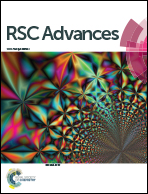Correlation between electrochromism and electronic structures of tungsten oxide films†
Abstract
The in-situ X-ray absorption spectroscopy of three tungsten oxide films was performed to study the electronic and atomic structures following repeated cycles of coloration and bleaching processes. The transparent tungsten oxide films become deep blue upon intercalation of Li+ ions in the WO6 octahedra when an external electrical bias was applied. These films reverted to transparent when a reverse external electrical bias was applied. W L3-edge X-ray absorption near-edge structure (XANES) measurements of the nanocrystalline and crystalline tungsten oxide films revealed that the intensity of the white-line feature decreases after coloration and recoverably increases after bleaching owing to the filling and unfilling of the W 5d–O 2p conduction band states. The second derivative of the W L3-edge XANES spectra indicated an increase in structural disordering following repeated cycles of coloration and bleaching. However, the extended X-ray absorption fine structure analysis showed that the nearest-neighbor W–O bond distances in the samples overall remain unchanged by coloration and bleaching. The nanocrystalline tungsten oxide film exhibited more effective recovery (∼97% after first cycle) of the electronic structures than the other two crystalline samples in terms of the filling and unfilling of the W 5d–O 2p conduction band states after repeated coloration and bleaching. These results show that the nanocrystalline tungsten oxide sample has superior electrochromic properties to the crystalline samples.


 Please wait while we load your content...
Please wait while we load your content...